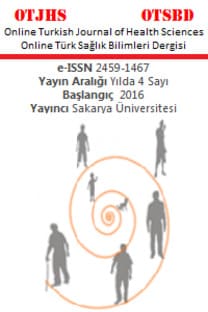Üçüncü Basamak Bir Hastanede Yatan COVID-19 Hastalarında Sekonder Enfeksiyonlar
antibiyotik kullanımı, COVİD-19, sekonder enfeksiyonlar, ventilatör ilişkili pnömoni
Secondary Infections in COVID-19 Patients Hospitalized in A Tertiary Hospital
___
- Sharifipour E, Shams S, Esmkhani M, et al. Evaluation of bacterial co-infections of the respiratory tract in COVID-19 patients admitted to ICU. BMC Infect Dis. 2020;20(1):646.
- Zhang H, Zhang Y, Wu J, et al. Risks and features of secondary infections in severe and critical ill COVID-19 patients. Emerg Microbes Infect. 2020;9(1):1958-1964.
- Nori P, Cowman K, Chen V, et al. Bacterial and fungal coinfections in COVID-19 patients hospitalized during the New York City pandemic surge. Infect Control Hosp Epidemiol. 2021;42(1):84-88.
- Póvoa HCC, Chianca GC, Iorio NLPP. COVID-19: An Alert to Ventilator-Associated Bacterial Pneumonia. Infect Dis Ther. 2020;9(3):417-420.
- Crotty MP, Akins R, Nguyen A, Slika R, et al. Investigation of subsequent and co-infections associated with SARS-CoV-2 (COVID-19) in hospitalized patients. medRxiv. 2020. doi: 05.29.20117176.
- Li J, Wang J, Yang Y, et al. Etiology and antimicrobial resistance of secondary bacterial infections in patients hospitalized with COVID-19 in Wuhan, China: a retrospective analysis. Antimicrob Resist Infect Control. 2020;9(1):153.
- Lansbury L, Lim B, Baskaran V, Lim WS. Co-infections in people with COVID-19: a systematic review and meta-analysis. J Infect. 2020;81(2):266-275.
- World Health Organization (WHO). COVID-19 Clinical management: living guidance. 25.01.2021. Available from: https://www.who.int/publications/i/item/WHO-2019-nCoV-clinical-2021-1. Accessed March 15,2021.
- Sieswerda E, de Boer MGJ, Bonten MMJ, et al. Recommendations for antibacterial therapy in adults with COVID-19 - an evidence based guideline. Clin Microbiol Infect. 2021;27(1):61-66.
- Zhou P, Liu Z, Chen Y, Xiao Y, Huang X, Fan XG. Bacterial and fungal infections in COVID-19 patients: A matter of concern. Infect Control Hosp Epidemiol. 2020;41(9):1124-1125.
- Langford BJ, So M, Raybardhan S, et al. Bacterial co-infection and secondary infection in patients with COVID-19: a living rapid review and meta-analysis. Clin Microbiol Infect. 2020;26(12):1622-1629.
- Rawson TM, Moore LSP, Zhu N, et al. Bacterial and Fungal Coinfection in Individuals With Coronavirus: A Rapid Review To Support COVID-19 Antimicrobial Prescribing. Clin Infect Dis. 2020;71(9):2459-2468.
- Infectious Diseases Society of America (IDSA). Management of Adults With Hospital-acquired and Ventilator-associated Pneumonia: 2016 Clinical Practice Guidelines by the Infectious Diseases Society of America and the American Thoracic Society. Available from: https://www.idsociety.org/practice-guideline/hap_vap/. Accessed March 1,2021.
- European Committee on Antimicrobial Susceptibility Testing (EUCAST). Breakpoint tables for interpretation of MICs and zone diameters. Version 10.0. Available from: https://www.eucast.org/fileadmin/src/media/PDFs/EUCAST_files/Breakpoint_tables/v_9.0_Breakpoint_Tables.pdf; 2020. Accessed February 1,2021.
- Fu Y, Yang Q, Xu M, et al. Secondary Bacterial Infections in Critical Ill Patients With Coronavirus Disease 2019. Open Forum Infect Dis. 2020;7(6):ofaa220.
- Lee SI, Koh JS, Kim YJ, et al. Secondary infection among hospitalized COVID-19 patients: A retrospective cohort study in a tertiary care setting. Respirology. 2021;26(3):277-278.
- Goncalves Mendes Neto A, Lo KB, Wattoo A, et al. Bacterial infections and patterns of antibiotic use in patients with COVID-19. J Med Virol. 2021;93(3):1489-1495.
- Garcia-Vidal C, Sanjuan G, Moreno-García E, et al. Incidence of co-infections and superinfections in hospitalized patients with COVID-19: a retrospective cohort study. Clin Microbiol Infect. 2021;27(1):83-88.
- Moretti M, Van Laethem J, Minini A, Pierard D, Malbrain MLNG. Ventilator-associated bacterial pneumonia in coronavirus 2019 disease, a retrospective monocentric cohort study. J Infect Chemother. 2021;27(6):826-833.
- Ripa M, Galli L, Poli A, et al. Secondary infections in patients hospitalized with COVID-19: incidence and predictive factors. Clin Microbiol Infect. 2021;27(3):451-457.
- Dudoignon E, Caméléna F, Deniau B, et al. Bacterial Pneumonia in COVID-19 Critically Ill Patients: A Case Series. Clin Infect Dis. 2021;72(5):905-906.
- Bardi T, Pintado V, Gomez-Rojo M, et al. Nosocomial infections associated to COVID-19 in the intensive care unit: clinical characteristics and outcome. Eur J Clin Microbiol Infect Dis. 2021;40(3):495-502.
- Koehler P, Bassetti M, Chakrabarti A, et al. Defining and managing COVID-19-associated pulmonary aspergillosis: the 2020 ECMM/ISHAM consensus criteria for research and clinical guidance. Lancet Infect Dis. 2021;21(6):149-162.
- Hughes S, Troise O, Donaldson H, Mughal N, Moore LSP. Bacterial and fungal coinfection among hospitalized patients with COVID-19: a retrospective cohort study in a UK secondary-care setting. Clin Microbiol Infect. 2020;26(10):1395-1399.
- ISSN: 2459-1467
- Yayın Aralığı: Yılda 4 Sayı
- Başlangıç: 2016
- Yayıncı: Oğuz KARABAY
Gebeliğin Intrahepatik Kolestazı ve Maternal-Fetal Sonuçları
Kemine UZEL, Filiz BİLİR, Bahar SARIIBRAHIM ASTEPE, Paşa ULUĞ, YUSUF KEMAL ARSLAN, Tunay KİREMİTLİ
Covid-19’un Nadir Bir Komplikasyonu Olan Pnömomediastinum
Canatan TAŞDEMİR, Yusuf AYDEMİR, Hasan DÜZENLİ
Mohamad Helmy JAAFAR, Normalina ALIAS, Muhammad Lokman MD. ISA
Fatih ŞAHİN, Havva KOÇYİĞİT, Fikret BAYAR, Ayça Taş TUNA
Loksapin, İloperidon, Paliperidon'un İzole Farelerde Vas Deferens Kasılması ÜzerineKronik Etkileri
Rümeysa KELEŞ KAYA, Oğuz MUTLU, Bekir Faruk ERDEN, Mehmet Emin BÜYÜKOKUROĞLU, Pelin TANYERİ, Mehmet Hanifi TANYERİ, Şeyma Nur BAŞARIR, Füruzan YILDIZ AKAR, Güner ULAK
Anjiyografi Hasta Plazmalarında, Paraoxonase 1, Arylesterase ve Total Thiol İncelemesi
hayrullah yazar, Güler KUŞÇU GÜNAY, Mustafa Baran İNCİ, Süleyman KALELİ, Mehmet Akif ÇAKAR
Sıçanlarda Amiodaronun Sebep Olduğu Akciğer Hasarında Beyaz Lahana Ekstraktının Koruyucu Rolü
Esin AK, İsmet Burcu TÜRKYILMAZ, Aleyna MUHAN, Refiye YANARDAG
Asuman DEVECİ ÖZKAN, Ayten HACIEFENDİ, Fatih ÖZKAN, Gamze Güney ESKİLER, Süleyman KALELİ, Ecir Ali ÇAKMAK, Özge TURNA
Tip 2 Diabetik Makula Ödemli Hastalarda Tedavi Karşılaştırması
